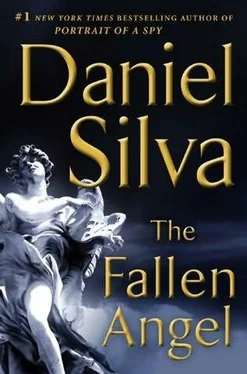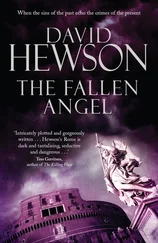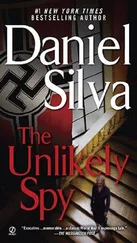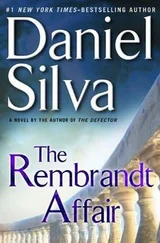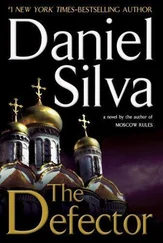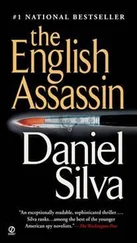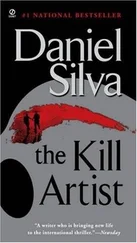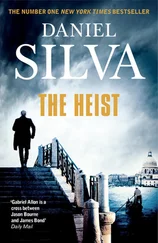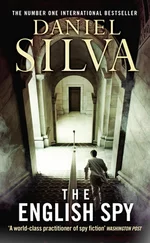It was that memory, the memory of Daniel dying in his arms, that compelled Gabriel into the cemetery. He remained at the grave for nearly an hour, thinking about the kind of man his son might have been, whether he would have been an artist like his ancestors or whether he would have found something more practical to do. Finally, as the church bells tolled one o’clock, he placed stones atop the grave and made his way across the Kidron Valley to Dung Gate. A group of Israeli schoolchildren from the Negev waited at the security checkpoint, their brightly colored knapsacks open for inspection. Gabriel briefly joined them. Then, after speaking a few words into the ear of a policeman, he slipped around the magnetometers and entered the Jewish Quarter.
Directly before him, across a broad plaza, rose the honey-colored Herodian stones of the Western Wall, the much-disputed remnant of the ancient retaining barrier that had once surrounded the great Temple of Jerusalem. In AD 70, after a ruthless siege lasting many months, the Roman Emperor Titus ordered the Temple destroyed and the rebellious Jews of Roman Palestine obliterated. Hundreds of thousands perished in the bloodletting that followed, while the contents of the Holy of Holies, including the great golden menorah, were carried back to Rome in one of history’s most infamous episodes of looting. Six centuries later, when the Arabs conquered Jerusalem, the ruins of the Temple were no longer visible—and the Holy Mountain, the place regarded by Jews as the dwelling place of God on Earth, was little more than an elevated garbage dump. The Arabs erected the golden Dome of the Rock and the great al-Aqsa Mosque, thus establishing Islamic religious authority over the world’s most sacred parcel of real estate. The Crusaders seized the Mount from the Muslims in 1099 and turned the shrines into churches, a tactical mistake the Israelis chose not to repeat after capturing East Jerusalem in 1967. Israeli authorities now maintained tight control over access to the Mount, but administration of the Muslim holy sites, and the sacred land beneath them, remained in the hands of the Islamic religious authority known as the Waqf.
The portion of the Western Wall visible from the plaza was 187 feet wide and 62 feet high. The actual western retaining wall of the Temple Mount plateau, however, was much larger, descending 42 feet below the plaza and stretching more than a quarter mile into the Muslim Quarter, where it was concealed behind residential structures. After years of politically and religiously charged archaeological excavations, it was now possible to walk nearly the entire length of the wall via the Western Wall Tunnel, an underground passageway running from the plaza to the Via Dolorosa. Waiting for Gabriel at the entrance was a young woman dressed in the modest skirt and headscarf of an Orthodox Jew. “He’s been working nonstop at a spot near the Cave,” she said in a confiding tone. “Apparently, he’s found something important, because he’s a complete wreck.”
“How can you tell?”
The woman laughed and then led Gabriel to the top of a narrow aluminum staircase. It bore him downward beneath the Old City and backward through history. He paused for a moment beneath Wilson’s Arch, the bridge that had linked the Temple Mount and Jerusalem’s Upper City in the time of Jesus, and then set out along a newly paved walkway at the base of the wall. The massive foundation stones were aglow with lamplight and cool to the touch. Just a few feet above were the chaotic market streets of the modern Muslim Quarter, but here in the basement of time the silence was absolute.
The section of the tunnel known as the Cave was actually a tiny grotto-like synagogue, set against the portion of the wall thought to be the nearest point to the ancient location of the Holy of Holies. As usual, a small group of Orthodox women were praying in the synagogue, their fingers pressed reverently to the stone. Gabriel slipped quietly past them and made his way toward a tarpaulin curtain hanging a few yards away. A small handwritten sign warned of danger and instructed visitors to stay away. Gabriel parted the curtains and peered down into an excavation trench approximately twenty feet deep. At the bottom, bathed in the glow of harsh white lights, a single archaeologist picked gently at the black earth with a tiny hand trowel.
“What is it?” Gabriel asked, his voice echoing into the void.
“It’s not an it ,” replied Eli Lavon. He moved aside to reveal the focus of his labors—the shoulder, arm, and hand of a human skeleton. “We call her Rivka,” he said. “And unless I’m mistaken, which is highly unlikely, she died the same night as the Temple.”
“Proof, Professor Lavon,” Gabriel said, challenging him playfully. “Where’s the proof?”
“It’s all around her,” said Lavon, pointing to the rectangular stones embedded in the soil. “They’re from the Temple itself, and they’re lying here because the Romans hurled them over the wall the night they laid waste to the House of God. The fact that Rivka’s remains lie amid the stones rather than under them suggests she was thrown over the wall at the same time. So do the fractures all over her body.”
Lavon gazed respectfully at the remains for a moment without speaking. “According to Josephus, our only source for what happened that night, several thousand Jews rushed into the Temple after the Romans set it ablaze. I suspect Rivka was one of them. Who knows?” he added with a sigh. “It’s possible she saw Titus himself entering the Holy of Holies to claim his sacred loot. After that . . . it was hell on earth.”
“Titus wasn’t the world’s first looter,” Gabriel said. “And, unfortunately, he wasn’t the last.”
“So I hear.” Lavon looked up. “I also hear someone tried to take a shot at you the other night in Rome.”
“Actually, I think he was aiming for my wife.”
“That was rather unwise. Is he still alive?”
“For the moment.”
“Any idea who sent him?”
Gabriel dropped the shard of Greek pottery into the excavation pit. Lavon snatched it deftly out of the air before it could shatter on the stones of the Temple and examined it in the glow of his work lamps.
“Red-figure Attic, fifth century BC, probably by the Menelaos Painter.”
“Very impressive.”
“Thank you,” replied Lavon. “But don’t ever drop it again.”
The Old City of Jerusalem was once again connected to the new by a footbridge. It stretched from the Jaffa Gate to the sparkling Mamilla Mall, one of the few places in the country where Arab and Jew mingled with relatively little tension. As usual, Gabriel and Lavon bickered over where to eat before finally settling on a fashionable European-style café. The Israel of their youth had been a land without television. Now it had all the creature comforts of the West, everything except peace.
The volume of the techno-pop music made conversation impossible inside, so they sat on the sunlit terrace at a table with a gunner’s view of the Old City walls. Lavon’s wispy hair moved in the breeze. He popped an antacid tablet before touching his food.
“Still?” asked Gabriel.
“It’s eternal, just like Jerusalem.”
Gabriel smiled. Sometimes even he found it hard to imagine that the bookish, hypochondriacal figure seated before him was regarded as the finest street surveillance specialist the Office had ever produced. He had worked with Lavon for the first time during Operation Wrath of God. For three years, they had been near-constant companions, killing both at night and in broad daylight, living in fear that at any moment they would be arrested by European police. When the unit finally disbanded, Lavon was afflicted with numerous stress disorders, including a notoriously fickle stomach. He settled in Vienna, where he opened a small investigative bureau called Wartime Claims and Inquiries. Operating on a shoestring budget, he managed to track down millions of dollars’ worth of looted Holocaust assets and played a significant role in prying a multibillion-dollar settlement from the banks of Switzerland. But when a bomb destroyed his office and killed two of his employees, Lavon returned to Israel to pursue his first love, archaeology. He now served as an adjunct professor of biblical archaeology at Jerusalem’s Hebrew University and regularly took part in digs around the country, such as the one in the Western Wall Tunnel.
Читать дальше
Конец ознакомительного отрывка
Купить книгу
